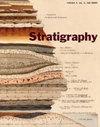Middle Pennsylvanian (Desmoinesian) Fusulinids of the Bug Scuffle Limestone Member of the Gobbler Formation, Sacramento Mountains, South-Central New Mexico
IF 0.9
3区 地球科学
Q3 GEOLOGY
引用次数: 0
Abstract
Analysis of fusulinids from the Bug Scuffle Limestone Member of the Gobbler Formation along the western escarpment of the Sacramento Mountains in south-central New Mexico demonstrates that all four Desmoinesian regional fusulinid zones documented in Midcontinent and Southwest North America are present in the stratigraphic unit. Earliest Desmoinesian (Df1 Zone) fusulinids from the basal Bug Scuffle limestone beds suggest that the carbonate unit transgressed northward on the Sacramento Shelf, with Beedeina insolita in basal beds of the southernmost canyon exposures, and the slightly more advanced B. hayensis and B. curta in basal limestone beds of more northern outcrops. Late early Desmoinesian (Df2 Zone) fusulinids are common and widespread throughout the escarpment outcrop belt indicating that it was the time period with the most widespread normal marine shelf paleoenvironmental conditions. The diverse assemblage of the Df2 Zone is characterized by Beedeina novamexicana, B. euryteines, B. leei, B. socorroensis, B. joyitaensis, Wedekindellina euthysepta, and W. excentrica. The microprobematical branching fossil Komia is also common in this zone. Wedekindellina and Komia do not range above the mid-Desmoinesian CSB1 composite sequence boundary. Above that sequence boundary, the early late Desmoinesian Df3 Zone is characterized by sparse Beedeina haworthi, and the closely related B. illinoisensis and B. tumida. The late late Desmoinesian Df4 Zone is represented by a diverse assemblage of fusulinids in the uppermost part of the Bug Scuffle Limestone Member in the southern canyon exposures, including Beedeina acme, B. megista, B. mysticensis, B. lonsdalenesis, B. bellatula, B. gordonensis, and B. vintonensis. No Beedeina identifiable to species were found in upper part of the Bug Scuffle Limestone Member in the northernmost canyon exposures, demonstrating that late Desmoinesian paleoenvironments became more restricted marine northward along the Sacramento Shelf. Above the CSB2 composite sequence boundary in the uppermost Bug Scuffle Limestone Member, the lower part of the uppermost depositional sequence continues to contain latest Desmoinesian Df4 Zone fusulinids in the southern canyon sections. Early Missourian conodonts have been reported in a limestone unit near the top of the Gobbler clastic detrital member in the north-central part of the outcrop belt(Wahlman and Barrick 2018; Lucas et al. 2021), but no early Missourian conodonts or fusulinids have been reported yet from the uppermost Bug Scuffle Limestone Member in the southern canyons.新墨西哥中南部萨克拉门托山脉的Gobbler组的Bug Scuffle石灰岩成员的中宾夕法尼亚(德摩因世)Fusulinids
对新墨西哥州中南部萨克拉门托山脉西部陡坡上Gobbler组的Bug Scuffle灰岩进行的褐藻质分析表明,在中大陆和北美西南部记录的四个德蒙尼世区域性褐藻质带都存在于该地层单元中。最早的德摩因世(Df1带)粗粒藻表明,在萨克拉门托陆架上,碳酸盐单元向北海侵,最南端峡谷暴露的基底中有Beedeina insolita,更早的B. hayensis和B. curta在更北部露头的基底灰岩层中。晚-早德摩因世(Df2带)毛藻藻在整个断崖露头带普遍分布,是正常海陆架古环境条件最广泛的时期。Df2区以新美洲蜂属(bedeina novamexicana)、欧洲蜂属(B. euryteines)、leei、socorensis、B. joyitaensis、Wedekindellina euthysepta和W. excentrica为特征。微问题分支化石Komia在该带也很常见。Wedekindellina和Komia的范围不超过中德摩尼世CSB1复合层序边界。在该序列边界之上,desmoines早、晚的Df3带以稀疏的bedeina haworthi和亲缘关系密切的B. illinois和B. tumida为特征。晚desmoines - Df4带以峡谷南部暴露的Bug Scuffle灰岩段最上部的丰富的fusulinids组合为代表,包括Beedeina acme、B. megista、B. mysticensis、B. lonsdalenesis、B. bellatula、B. gordonensis和B. vintonensis。在峡谷最北端暴露的Bug Scuffle石灰岩段上部未发现可识别物种的Beedeina,表明晚德摩因世古环境沿萨克拉门托陆架向北变得更加受海洋限制。在最上面的Bug混战灰岩段CSB2复合层序边界之上,最上面的沉积层序下部在峡谷南段继续发育最新的德摩尼世Df4带fusulinids。据报道,在露头带中北部Gobbler碎屑碎屑段顶部附近的石灰岩单元中发现了早期密苏里牙形刺(Wahlman and Barrick 2018;Lucas et al. 2021),但在南部峡谷最上面的Bug Scuffle石灰岩成员中尚未报道早期密苏里牙形刺或镰状刺。
本文章由计算机程序翻译,如有差异,请以英文原文为准。
求助全文
约1分钟内获得全文
求助全文
来源期刊

Stratigraphy
地学-地质学
CiteScore
1.80
自引率
6.70%
发文量
0
审稿时长
>12 weeks
期刊介绍:
The journal’s mission is to publish peer-reviewed papers that use modern stratigraphic tools – biostratigraphy, chemostratigraphy, magnetostratigraphy, cyclostratigraphy, sequence stratigraphy, climatostratigraphy, lithostratigraphy, GSSPs and more – to explore broad ideas in earth history.
 求助内容:
求助内容: 应助结果提醒方式:
应助结果提醒方式:


